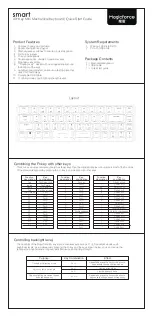
Program mode: HD-1
92
AMS A Decay
[00…+99]
This controls the decay time of the smoother, or how
long it takes the smoother to reach a new,
lower
value.
Higher Decay settings mean longer times.
Shape
This Mixer Type adds curvature to the AMS input.
Shape can create custom controller curves, such as
exponential joystick, logarithmic velocity, and so on. It
can also alter the shape of programmable modulation
sources, such as EGs and LFOs.
Note:
Shape only affects AMS signals which already
have some amount of slope, such as EGs, triangle and
sine LFOs, and so on. It does not affect signals which
only contain abrupt transitions, such as square waves.
AMS A
[List of AMS Sources]
This selects the AMS input source to be shaped.
For a list of AMS sources, see “AMS (Alternate
Modulation Source) List” on page 967.
Mode
[Symmetric, Asymmetric]
This selects whether Shape will produce one or two
curves. The graphic “AMS Mixer Shape examples”
may help to visualize how this works.
Asymmetric
will produce a single curve, extending
from –99 to +99.
Symmetric
will produce two matching curves
extending outwards from 0 to –99 and +99,
respectively.
Shape
[–99…+99]
This controls the amount of curvature, and whether the
curves are concave or convex. As you can see in the
graphic examples, the shape will tend to emphasize
certain value ranges, and de-emphasize others.
For example, let’s say that you are using a triangle
LFO, through Shape, to modulate filter cutoff. If Shape
emphasizes the high value range, the filter will spend
more time at the higher frequencies. If it emphasizes
the low range, the filter will spend more time at the
lower frequencies.
AMS Mixer Shape examples
Bipolar and Unipolar AMS sources
To understand Shape, it helps to understand the
difference between
bipolar
and
unipolar
AMS sources.
Bipolar
sources can swing all the way from –99 to +99,
with 0 in the middle. Most LFOs are bipolar, for
instance; so is Pitch Bend.
Generally, bipolar AMS sources will work better with
the
Asymmetric
mode, but
Symmetric
may also
produce interesting results.
Here’s a handy chart which shows the results of Shape with the different settings and input types:
Mode
Input
Shape
Result
Symmetric
Unipolar
Positive (+)
emphasizes upper value range
Negative (-)
emphasizes lower value range
Bipolar
Positive (+)
emphasizes both upper and lower value ranges,
and de-emphasizes the center
Negative (–)
emphasizes center value range, around 0
Asymmetric
Unipolar
Positive (+)
emphasizes extreme upper range, with offset
Negative (–)
emphasizes extreme lower range, with offset
Bipolar
Positive (+)
emphasizes upper value range
Negative (–)
emphasizes lower value range
+99
0
–99
+99
0
–99
+99
0
–99
Symmetric
Asymmetric
+99
0
–99
Symmetric
Asymmetric
Bipolar Triangle Wave
Symmetric
Asymmetric
Bipolar Sawtooth Wave
Shape = 0 (original waveform)
Shape = +99
Shape = –99
Asymmetric
(not recommended)
Unipolar Triangle Wave
Symmetric
Summary of Contents for Electronic Keyboard
Page 1: ...Parameter Guide Parameter Guide ...
Page 2: ......
Page 180: ...Program mode EXi 170 ...
Page 290: ...EXi STR 1 Plucked String 280 ...
Page 572: ...Sequencer mode 562 ...
Page 700: ...Global mode 690 ...
Page 751: ...Insert Effects IFX1 IFX12 Routing 741 Fig 2 3a Fig 2 3b ...
Page 902: ...Effect Guide 892 ...
















































